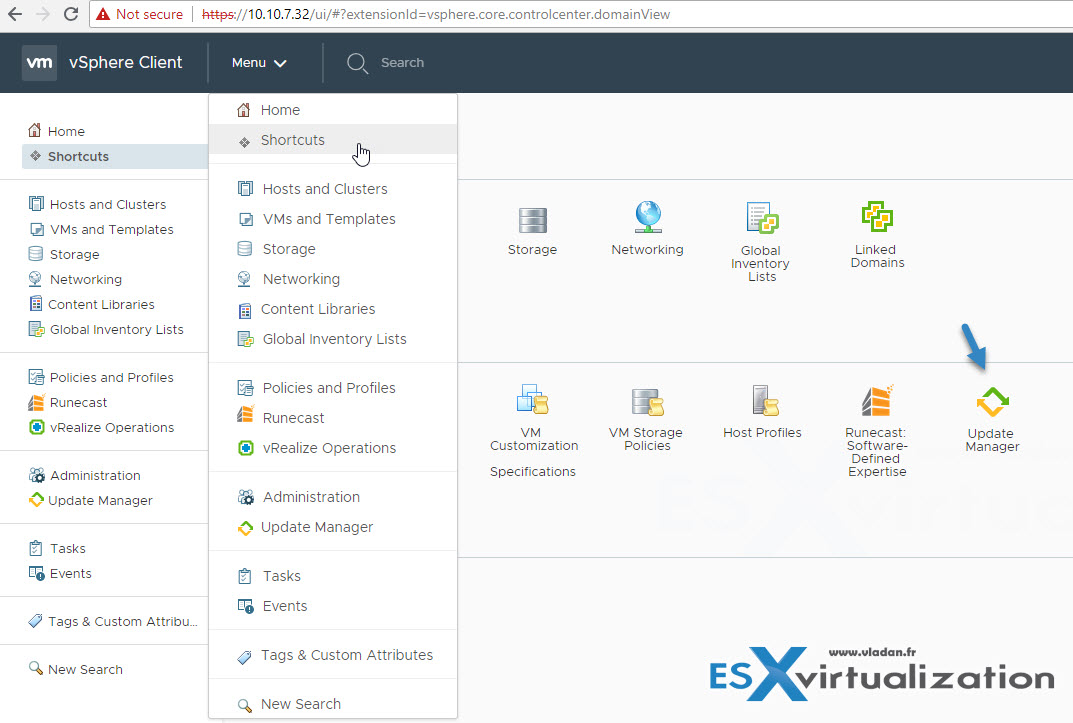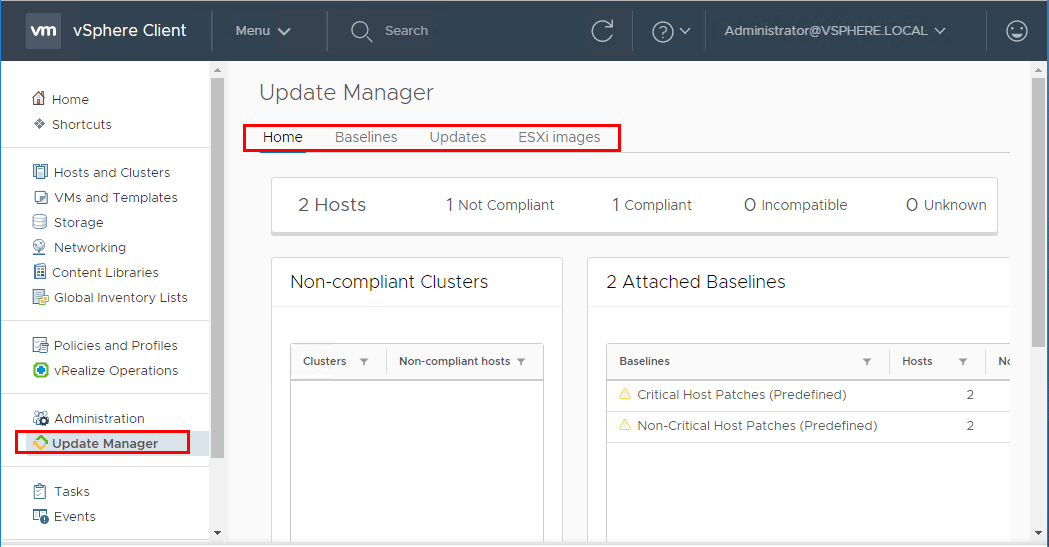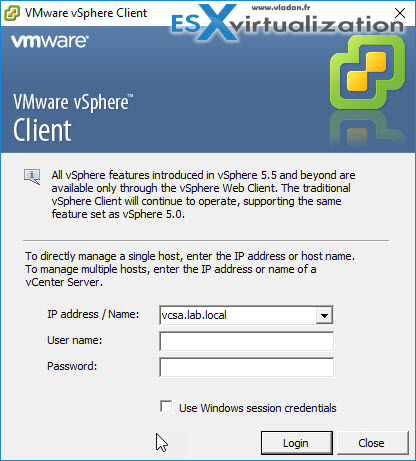MyVMware Patch Download Important Notice for existing subscribers: Subscribe: ESXi Version 6.7.0 History. Imageprofile ESXi-6.7.0-8169922-standard (Build 8169922) is the GA release of ESXi 6.7.0. VMware vSphere 6.7 Update 1 Free Download for Windows based system based on 64 bit architecture. Setup file is completely standalone and also its an offline installer.VMware vSphere 6.7 Update 1 is an outstanding application for handling complex tasks in a cloud- based system. In this article, we’ll consider how to add (inject) drivers into the ESXi 6.7 installation ISO image. Despite VMWare ESXi image is certified (supported) for most popular server models, it doesn’t contain hardware drivers for all of them (unlike Windows). VSphere 6.7 has officially GA'ed! Below is an aggregation of all the related release notes and downloads for this vSphere release. I have also created a short URL which you can use to access this exact same page using vmwa.re/vsphere67 Note: Not all links are live yet, but they should be available. You can also run most vSphere CLI commands against a vCenter Server system and target any ESXi system that vCenter Server system manages. VSphere CLI also includes a set of host management commands: the ESXCLI command set, vicfg- commands, and some other commands. VSphere CLI also includes DCLI commands, which allow you to manage services in. I have tried to update my VMware ESXi 6.7 host to ESXi-6.7.0-1-standard (Build 14320388) today. On the host’s SSH console, the command to use is. All code samples and downloads are copyright Ulrich Krause and licensed under Apache License 2.0. Buy me a coffee.
- Download Esxi 6.7 Hpe
- Free Esxi 6.7
- Download Esxi 6.7 For Hp
- Download Esxi 6.7 U3 Iso
- Download Esxi 6.7 Free
- Download Esxi 6.7 Lenovo
- Download Esxi 6.7 Custom Hp
In this article, we’ll consider how to add (inject) drivers into the ESXi 6.7 installation ISO image. Despite VMWare ESXi image is certified (supported) for most popular server models, it doesn’t contain hardware drivers for all of them (unlike Windows). If you try to install ESXi 6.7 image on a typical desktop computer, you are likely to face the situation when you don’t have a driver for some hardware (RAID controller, video card or network adapter, etc.) in your installation ESXi ISO.
The most frequent error you see when trying to install ESXi from the original ISO image on a desktop computer is ‘No Network Adapters’. Indeed, the ESXi image doesn’t support most of LAN NIC adapters. To install ESXi on such a computer, you will have to inject the drivers for your network adapter into your ESXi installation image.
Let’s see how to add a driver to the VMware ESXi 6.7 installation ISO. In this example we’ll show how to integrate the driver for Realtek network adapter into the VMWare ESXi image.
To customize ESXi images VMware recommends using official tool – vSphere ESXi Image Builder. But is it very specific and requires vCenter Server Appliance (vCSA). Most system administrators use a third-party tool ESXi-Customizer instead.
How to Find and Download Drivers for VMWare ESXi?
First of all, you must to find drivers for your hardware. You can search for them in VMware Compatibility Guide section on VMware website, on the vendor website, on the website of ESXi-Customizer author’s (https://vibsdepot.v-front.de/wiki/index.php/List_of_currently_available_ESXi_packages — I have downloaded the driver net55-r8168 for my Realtek network adapter here) or using Google search (something like “Realtek NIC drivers for ESXi”).
Please note that you need the driver in one of the following formats: .vib, .tgz or .zip (offline bundle).
You can also find the drivers by device VID. Boot your computer using Linux LiveCD and find VID and DID of your device, for example, by running this command:
lspci -nn
Using these IDs, you can search .vib drivers in the Web.
How to Inject a Driver into ESXi Image Using ESXi-Customizer GUI Tool?
ESXi-Customizer is a graphical tool with a simple interface that allows you to make the integration of drivers and .vib files into ESXi ISO automatic.
Download ESXi-Customizer-v2.7.2.exe (https://www.v-front.de/p/esxi-customizer.html), extract the archive and run the tool (ESXi-Customizer.cmd). ESXi-Customizer does not officially support Windows 10, so when started in Windows 10, this error appears:

To fix it, edit the ESXi-Customizer.cmd file and comment the following line (add REM in the beginning):
if '!WinVer!' LSS '5.1' call :earlyFatal Unsupported Windows Version: !WinVer!. At least Windows XP is required & exit /b 1
Save ESXi-Customizer.cmd file and run it again. In the next window, specify the path to the original ESXi ISO image, the driver file (VIB file or TGZ archive with drivers) and the folder, to which the resulting ISO image with the integrated driver must be saved. Uncheck the automatic update option.
Click the Run button and after a few minutes a new ESXi ISO image will appear in the target directory. You can use this image to install ESXi on your hardware.

Adding Drivers Using the PowerShell Script – ESXi-Customizer-PS
The ESXi-Customizer-PS (https://www.v-front.de/p/esxi-customizer-ps.html) PowerShell script can be used to integrate drivers and updates into the ESXi 5.x and 6.x install image. To use this script, VMware PowerCLI 5.1 or newermust be installed on your computer.
Download ESXi-Customizer-PS-v2.6.0.ps1 file (unblock the PS1 file downloaded from the Internet by checking Unblock in its properties) and start PowerCLI. Run the command:
Set-ExecutionPolicy -ExecutionPolicy RemoteSigned
You can display help on the script parameters as follows:
Download Esxi 6.7 Hpe
ESXi-Customizer-PS-v2.6.0.ps1 –help
To download the latest ESXi 6.7 ISO image version with the latest updates from VMware Online Depot website, run this command:
.ESXi-Customizer-PS-v2.6.ps1 -v67
Free Esxi 6.7
In the same way you can download other ESXi versions (-v67 | -v65 | -v60 | -v55 | -v51 | -v50).
To generate an ESXi ISO and immediately inject all offline bundles and VIB driver packages from C:distresxidriver, use this command:
.ESXi-Customizer-PS-v2.6.0.ps1 -v67 -pkgDir C:distresxidriver
In 15-20 minutes, the installation ESXi ISO image will appear in the targer directory.
You can modify the downloaded offline bundle (it is a ZIP archive with the ESXi installation files) by adding to it all VIB drivers from the specified directory:.ESXi-Customizer-PS-v2.6.0.ps1 -izip .VMware-ESXi-6.7.0-9484548-HPE-Gen9plus-670.10.3.5.6-Sep2018.zip -pkgDir C:distresxidriver
Using the following command, you can create an ESXi ISO from your offline bundle:
.ESXi-Customizer-PS-v2.6.0.ps1 -izip .VMware-ESXi-6.7.0-9484548-HPE-Gen9plus-670.10.3.5.6-Sep2018.zip
In V-Front online storage there is a large VIB driver library, and you can integrate the specific drivers from this depot into your ESXi image as follows:
.ESXi-Customizer-PS-v2.6.0.ps1 -v67 -vft -load sata-xahci,net55-r8168,net-e1000e,esx-ui
In this example, we’ll integrate these drivers into the ESXi distribution:
- net-e1000e – a network driver for Intel I21782579LM/82574L;
- net51-r8169 – Realtek 8168/8111/8411/8118 NIC driver (it has been removed from ESXi 5.1 and newer);
- esx-ui — ESXi Embedded Host Client — a convenient host web interface (used by default from esxi 5.5);
- sata-xahci — map driver to correctly identify some SATA controllers.
As a rule, for most computers it is enough to add the following drivers into the ESXi image:
-v60 -sip -vft -load net-e1000e,net51-r8169,net55-r8168,esx-ui,sata-xahci,net51-sky2,esxcli-shell
To update the offline bundle with the latest patches from VMware repository, run this command:
.ESXi-Customizer-PS-v2.6.0.ps1 -v67 -izip .VMware-ESXi-6.7.0-9484548-HPE-Gen9plus-670.10.3.5.6-Sep2018.zip -update
VMware ESXi: How to Kill an Unresponsive (Stuck)...
October 9, 2019PowerShell: Generating QR Code for Wi-Fi Network in...
October 8, 2019Wi-Fi Network Disappears After Sleep/Wake/Hibernate in Windows 10
October 4, 2019How to View and Parse WindowsUpdate.log on Windows...
September 25, 2019
Download Esxi 6.7 For Hp
Unable to Unmount/Delete VMFS Datastore: The Resource Is...
September 18, 2019Well, the upgrades are beginning in the home lab for getting everything up to vSphere 6.7 Update 2. There are many ways to update ESXi to the latest version and I have to say VMware has made this process rock solid. There have been many improvements made to the update process including vSphere Update Manager or VUM. In this post, let’s take a look at the process to upgrade VMware vSphere ESXi to 6.7 Update 2 new features.
New Improvements in VUM with vSphere 6.7 Update 2
Download Esxi 6.7 U3 Iso
The integration of VUM into the VCSA appliance has been a turning point in the upgrade and update ease that we as vSphere administrators have access to. The integration is seamless and now with the new HTML 5 vSphere client, the interface is responsive, intuitive, and “just works”. Once you have upgraded your VCSA appliance to vSphere 6.7 Update 2, there are new improvements to speak of that make this the best VUM ever.
VMware has been concentrating a lot of effort on making sure all of their products are very vSAN aware. One of the new features with VUM that directly relates to vSAN is a new checkbox found in the Remediate dialog box under the Remediate Settings section. The setting is Check host health after installation.
What does this new option do? Straight from VMware here: “With vCenter Server 6.7 Update 2, the vSphere Client provides a check box Check host health after installation that allows you to opt-out vSAN health checks during the upgrade of an ESXi host by using the vSphere Update Manager. Before introducing this option, if vSAN issues were detected during an upgrade, an entire cluster remediation failed and the ESXi host that was upgraded stayed in maintenance mode.”
One of the other enhancements that makes life easier now is the ability to select multiple baselines in the vSphere Client VUM remediation wizard. Prior to vSphere 6.7 Update 2, you had to create a Baseline Group to achieve the same result as the behavior we had in the Flex client. However, now with vSphere 6.7 Update 2, we can once again select multiple baselines to perform remediation.
VMware ESXi vSphere 6.7 Update 2 New Features
Download Esxi 6.7 Free
What are the new features found in VMware ESXi vSphere 6.7 Update 2? Below is straight from the release notes for ESXi 6.7 Update 2.
Download Esxi 6.7 Lenovo
- Solarflare native driver: ESXi 6.7 Update 2 adds Solarflare native driver (sfvmk) support for Solarflare 10G and 40G network adaptor devices, such as SFN8542 and SFN8522.
- Virtual Hardware Version 15: ESXi 6.7 Update 2 introduces Virtual Hardware Version 15 which adds support for creating virtual machines with up to 256 virtual CPUs. For more information, see VMware knowledge base articles 1003746 and 2007240.
- Standalone ESXCLI command package: ESXi 6.7 Update 2 provides a new Standalone ESXCLI package for Linux, separate from the vSphere Command Line Interface (vSphere CLI) installation package. The ESXCLI, which is a part of the vSphere CLI, is not updated for ESXi 6.7 Update 2. Although the vSphere CLI installation package is deprecated for this release and is still available for download, you must not install it together with the new Standalone ESXCLI for Linux package. For information about downloading and installing the Standalone ESXCLI package, see VMware {code}.
- In ESXi 6.7 Update 2, the Side-Channel-Aware Scheduler is updated to enhance the compute performance for ESXi hosts that are mitigated for speculative execution hardware vulnerabilities. For more information, see VMware knowledge base article 55806.
- ESXi 6.7 update 2 adds support for VMFS6 automatic unmap processing on storage arrays and devices that report to ESXi hosts an unmap granularity value greater than 1 MB. On arrays that report granularity of 1 MB and less, the unmap operation is supported if the granularity is a factor of 1 MB.
- ESXi 6.7 update 2 adds VMFS6 to the list of supported file systems by the vSphere On-disk Metadata Analyzer (VOMA) to allow you to check and fix issues with VMFS volumes metadata, LVM metadata, and partition table inconsistencies.
Upgrade VMware vSphere ESXi to 6.7 Update 2 with VUM New Features
Let’s run through the process of upgrading VMware vSphere ESXi to 6.7 Update 2 with VUM new features to demonstrate the ease of which this can be accomplished. The below VUM update is accomplished using my newly updated VCSA appliance instance which is already running vSphere 6.7 Update 2. Check out the process here to upgrade VCSA appliance to vSphere 6.7 Update 2 using the VAMI interface.
Simply click the Remediate button to begin the process of remediating your vSphere ESXi host. The host will install the updates, reboot, and should come back online in vCenter Server. After remediating your host with critical and non-critical patches, you should see the current version as VMware ESXi, 6.7.0, 13006603.
Download Esxi 6.7 Custom Hp
Wrapping Up
This is certainly the best VMware ESXi version ever. The VMware vSphere 6.7 Update 2 release brings great new features and functionality to the platform. The process to Upgrade VMware vSphere ESXi to 6.7 Update 2 with VUM is easy, intuitive, and more seamless than ever. It is great to see VMware continuing to make improvements to their products to account for vSAN and vSAN environments/architecture.